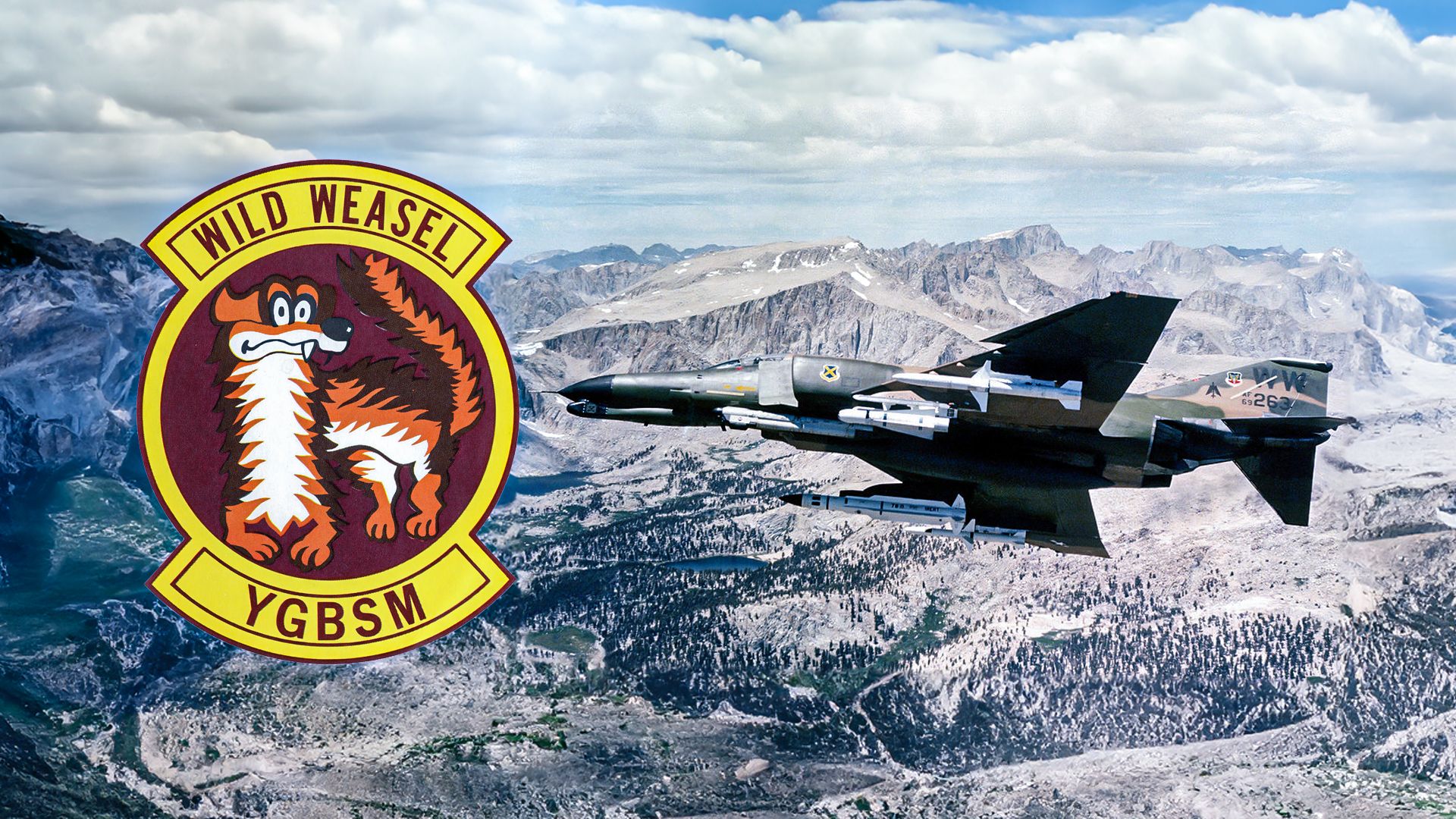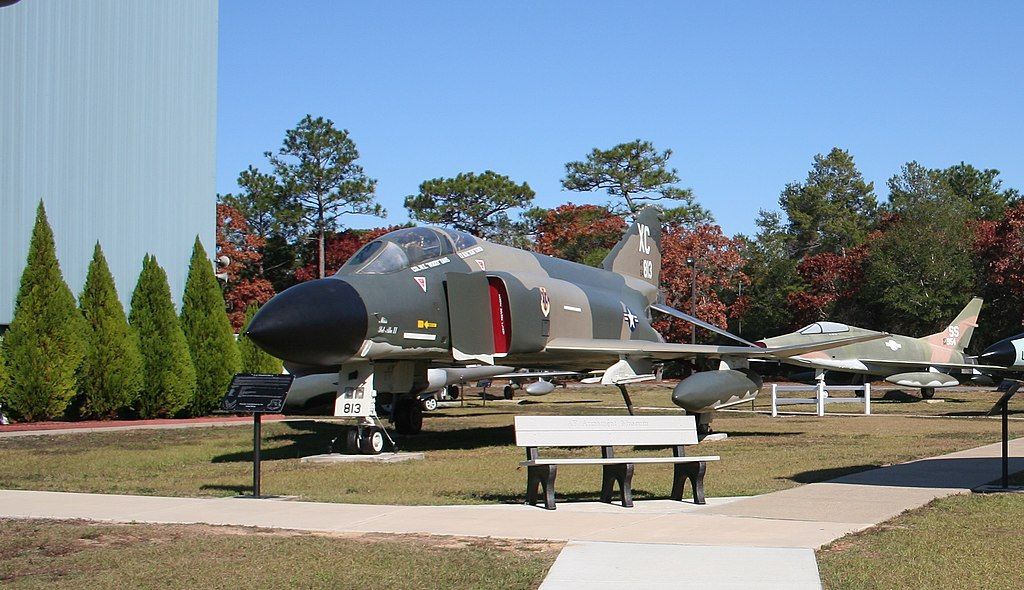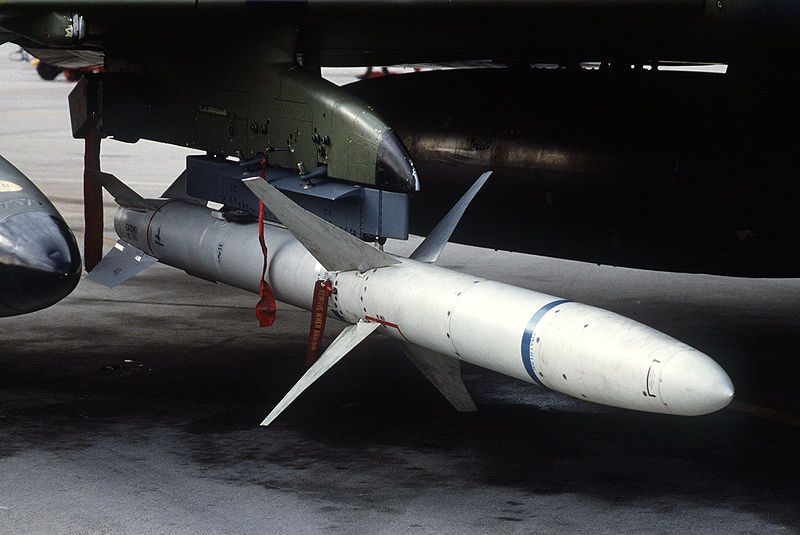Summary
- Wild Weasel missions predated the Persian Gulf War.
- F-4 Phantoms played a crucial role in SEAD missions.
- F-16 Fighting Falcons now continue the Wild Weasel program.
I first heard the term “Wild Weasel” used in the military aviation context at the tender age of 15 back on January 17, 1991, the first night of the Persian Gulf War (AKA Operation Desert Storm). Like so many fellow Americans, my parents and I were glued to the TV set watching the latest news developments on the war, and at one point, then-NBC News Pentagon correspondent Fred Francis made mention of the F-4G Wild Weasel and its unenviable job of attacking then-Iraqi dictator Saddam Hussein’s formidable French-made “KARI” integrated air defense system (IADS) (consisting of air defense radars and surface-to-air missile [SAM] launchers).
The technical term for this type of mission is SEAD (Suppression of Enemy Air Defenses).
I remember thinking at the time (1) what a ballsy mission that was to undertake and (2) what a badass nickname “Wild Weasel” was. Well, as I would eventually learn much, much later on, the concept of Wild Weasel missions predated Operation Desert Storm by a solid quarter-century. Simple Flying now examines the proud history of one of the most dangerous yet vitally necessary air combat missions in the US Air Force.
The “YGBSM” acronym at the bottom of the Willie the Weasel patch stands for “You Gotta Be Sh*ttin’ Me.” It was inspired by Jack Donovan, an electronic warfare officer (EWO) on the B-52 bomber during the Vietnam War.
What’s in a name?
In Mother Nature’s world, a weasel is a small predatory mammal of the genus Mustela of the family Mustelidae, a genus that also includes polecats, stoats, ferrets, and European mink. In the metaphorical human world, the word is used to describe “a cunning, sneaky person” (according to Dictionary.com); the most famous was the late great professional wrestling manager and pro-“heel” (bad guy) color commentator Bobby “The Brain” Heenan (November 1, 1944 – September 17, 2017), who was derisively nicknamed “Weasel” by the fans and pro-“babyface” (good guy) commentators alike, much to his (kayfabe) chagrin and irritation.
So then, how did the name become applied to the USAF SEAD mission and its associated warbirds?
Well, the missions were initially assigned by the operational code “Iron Hand” when first authorized on August 12, 1965, to counter the North Vietnamese SAM threat; the term “Wild Weasel” derives from Project Wild Weasel, the USAF development program for a dedicated SAM-detection and suppression aircraft. Originally named “Project Ferret” (i.e., one of the other Mustlidae mammalian members), denoting a predator that infiltrates its prey’s den to kill it (hence, “to ferret out”), the name was changed to “Weasel” to differentiate it from the code name “Ferret” that had been used during the Second World War for radar countermeasures bombers.
Wild Weasel I: North American F-100F Super Sabre (1965)
With General Keith Dempster heading up the program, the Super Sabre was the first warbird chosen for these harrowing missions. The F-100s weren’t equipped with dedicated anti-radiation missiles, instead relying upon conventional rockets, bombs, cannon, and (initially) napalm for SEAD duty.
According to Walter J. Boyne in his book Beyond the Wild Blue: A History of the U.S. Air Force, 1947-2007 (2nd Edition):
“The first Wild Weasel success came soon after the first Wild Weasel mission 20 December 1965 when Captains Al Lamb and Jack Donovan took out a site during a Rolling Thunder strike on the railyard at Yen Bai, some 75 mi (120 km) northwest of Hanoi.”
However, though the F-100F was a reasonably effective airframe for Wild Weasel missions, it didn’t have the performance characteristics to survive in a high-threat environment; the first unit to acquire the warbirds, the 354th Tactical Fighter Squadron based at Takhli Royal Thai Air Base, Thailand, was whittled down to one surviving plane after 45 days of combat ops. Of the 16 aircrew members, four had been killed in action (KIA), two were prisoners of war (POWs), three had been wounded (WIA), and two had thrown in the proverbial towel.
“Don’t give me a One-Double-Oh
To fight against friendly or foe
Don’t give me a One-Double-Oh
Just give me operations way out on some lonely atoll
For I am too young to die; I just want to grow old”
–“Give Me Operations, as sung by Dick Jonas, Lt. Col., USAF (Ret.) (5:11 mark)
Wild Weasel II and III: McDonnell Douglas F-4C Phantom II and Republic F-105F/G Thunderchief (circa 1965-1966)
The Phantom II was chosen as Wild Weasel II. However, though the F-4 would eventually go on to amass a legendary combat history, the F-4C initially underwhelmed as a SEAD platform. In the summer of 1966, the proverbial torch was passed onto the F-105F, now designated the Wild Weasel III. The Thunderchief was accordingly equipped with more advanced radar, jamming equipment, and a heavier armament; indeed, the “Thuds” were the first Wild Weasel warbirds that were armed with a dedicated anti-radiation missile, the AGM-45 Shrike:
The F-105F airframes were soon modified with improved countermeasures components in a standardized configuration, designated the F-105G while retaining the Wild Weasel III designation; 61 such F-105F specimens received these upgrades.
To quote two more verses of “Give Me Operations“:
Don’t give me an F-105
‘Cause I like being alive
She’s great for attack
She soaks up mach-mach flak
Don’t give me an F-105
(6:48 mark)
CHORUS
Don’t give me an old F-4C
With a navigator flying with me
Her dihedral’s neat
But she’s got a back seat
Don’t give me an old F-4C
(7:20 mark)
CHORUS”
And one good relevant Dick Jonas song citation deserves another:
Wild Weasel IV: the F-4C (redux) (circa 1966 to 1978)
By 1964, the F-105 was out of production. The severe combat attrition of the Thunderchief inventory (it was given the morbidly humorous nickname of “Thud” for a reason) spurred a compelling need for a more sophisticated aircraft; thus, we saw the comeback & conversion of 36 F-4C Phantom II aircraft, designated F-4C Wild Weasel IV (and unofficially the EF-4C).
This second chance for the F-4C as a Wild Weasel warplane proved to be much more fruitful, lasting roughly a dozen years.
Wild Weasel V: the F-4G Phantom II (1978 to 1996)
Ah, so now we come full circle to the teenage flashback I shared at the beginning of this article.
The F-4G would prove to be the metaphorical swan song of the legendary McDonnell Douglas F-4 Phantom II as a front-line combat aircraft in US service.
Though the F-4G officially went operational in 1978, it actually made its maiden flight in 1975.
The F-4G was, in essence, a modified F-4E with the cannon replaced by the AN/APR-47 electronic warfare equipment; a tad bit ironic in light of the fact that early versions of the F-4 were considered disadvantaged against North Vietnamese MiG-21 “Fishbeds,” MiG-19 “Farmers,” and MiG-17 “Frescoes” due to the lack of a gun. An improved version of the AN/APR-38 Wild Weasel system, the ’47 is a radar warning receiver (RWR) designed specifically for the F-4G, using a modified directional receiver unit designed by E-Systems (headquartered in Greenville, Texas, before being bought out by Raytheon in May 1995) to increase target location capabilities; it performs detection, location, and jamming of radar emissions.
As the late great Robert F. Dorr (September 11, 1939 – June 12, 2016; fellow Air Force veteran and aviation history author) wrote back in January 2011 for Defense Media Network:
“According to the official history of the 1991 Persian Gulf War, F-4G Advanced Wild Weasels from the 35th Tactical Fighter Wing at George Air Force Base, Calif., and the 52nd TFW at Spangdahlem, Germany, flew 3,942 combat sorties, fired 1,000 air-to-ground missiles, and destroyed 200 Iraqi missile sites. Operation Desert Storm was the only combat appearance of the F-4G.”
“‘I had my 40th birthday over Baghdad with fireworks and everything,’ said retired Lt. Col. Robert ‘Muskrat’ McNeese, an F-4G pilot, who was a major at the time of that personal milestone on Jan. 30, 1991…’On most missions up to Baghdad, we used “beer” callsigns, PABST, BUDWEISER, MILLER for each four-ship flight’…One of our early targets was the airfield at al Taqaddum near Fallujah. That airfield had MiG-29s. It had SA-2 and SA-3 missiles. We were called missile killers but we could also attack their long-range search radars’”…The Weasels started out by targeting Iraq’s longest-range missile, the SA-2. ‘After we rolled them back we would go after the SA-6s,’ McNeese said. ‘We were taking down their air defense system so their SAM sites were on “autonomous” mode, which meant they were, in effect, looking through a soda straw searching for us.'”
During this conflict, the Wild Weasels used the AGM-88 High-speed Anti-Radiation Missile (HARM), which was a significant improvement over the Shrike because of a superior ability to accurately strike the enemy radar sites even if those radars were turned off.
The Shrike was officially retired in 1992.
The F-4G was retired in 1996. Unlike the F-4C variant, of which there are multiple survivors on static display at museums and airfields around the world, I’m aware of only one surviving F-4G that’s been preserved for posterity. It has been on display at the Cold War Gallery of the National Museum of the United States Air Force at Wright-Patterson AFB (in the vicinity of Dayton), Ohio, since September 1996.
When I was stationed at Tyndall AFB (in the vicinity of Panama City), Florida as a 2nd Lieutenant attending Air Battle Manager (ABM) School from September 2001 to March 2003, they were using a bunch of the old Phantoms as target practice drones for the F-15C Eagle pilot trainees. At least they were going out in the proverbial blaze of glory, which, I reckon, is a helluva lot better than being left to slowly rot in “The Boneyard” at Davis-Monthan AFB (in the vicinity of Tucson), Arizona.
The present and future of the Wild Weasel program
The Lockheed Martin F-16 Fighting Falcon (AKA “Viper”) Block 50 and 52 took over Wild Weasel duties from the F-4G and, last I heard, is still officially designated for these duties. These Wild Weasel iterations of the “Viper” (yes, mixing mammalian and reptilian metaphors here) were officially redesignated as the F-16/CJ/DJ. Another Lockheed Martin product, the 5th Generation Lightning II stealth fighter, is slated to gradually replace the Viper for Wild Weasel duties. Still, I’m not aware of any official target dates having been announced for this transition.



